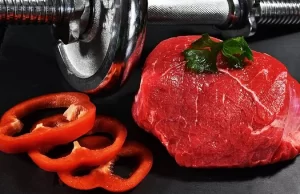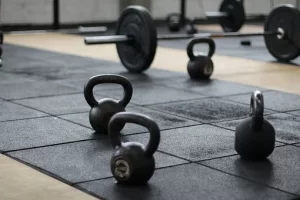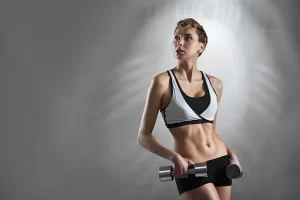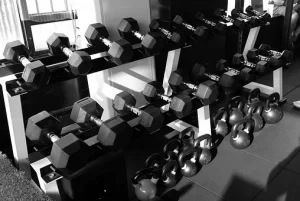dumbbell set
Best Dumbell Workout and Exercise For Full Body Workout
Do you know Exercising with dumbbells is good for improving strength, endurance, and muscles? Dumbbells are the most basic and comprehensive training equipment, whether training muscle hypertrophy, explosive power, muscle strength, or muscle endurance. In weight training exercises, dumbbells are a piece of essential training equipment. Different types of training methods can be carried out according to your training goals. Regardless of training maximum muscle strength, muscle hypertrophy, explosive power, or muscle endurance, it can be a kind of training. It is the most comprehensive and basic training equipment.
What are Dumbbells and their advantages?
Dumbbells, free weight equipment, can increase the participation of small muscle groups to help stabilize during training.
● Compared with mechanical training on a fixed track, it can only train large muscle groups, so the training for large muscle groups is Excellent but often ignores the movement of a lot of small muscle groups.
● Another advantage of dumbbells is that they can be adjusted according to each person’s body movements while maintaining the correct actions. Compared with mechanical training, although the height or position of the equipment can be adjusted, these movement tracks will not be affected by these. The adjustment has changed, and the body movement still follows the fixed method of mechanical training.
● It is also the action training that many athletes use dumbbells to do particular sports after mechanical movement. This training method can make their muscles more complete to meet their training needs. At the same time, they also use free weight training to avoid muscle strength—the problem of imbalance.
● And dumbbells can exercise your biceps, triceps, shoulders , back, and chest muscles. You can lift twice at home if you have nothing to do.
Pricing And Purchasing:
Choose dumbbells of the right weight and buy a set of dumbbells if possible. It is good to purchase dumbbells of various weights because you can challenge yourself during the exercise.
There are different packages available on the our official Website—a different number of dumbbells with each box, which you can get at a discount price.
● £19.99
● £12.99
● £9.99
● £14.99
➔ Many more are available at different prices.
The best combination of weight is to do exercises with two dumbbells. To test whether the dumbbell combination is right for you, you can pick up the lightest one. Raise and lower ten times. If you feel tired and think you can’t lift more than 10 times, this combination is too heavy for you.
Best Exercise and Workout With Dumbbell:
A graceful figure is inseparable from a smooth shoulder shape. Combined with a compact back, it can create a visual effect with a thinner waist. It is the so-called V-shaped figure, which is also the shape most people pursue.
➔ Don’t make any excuses. Let’s get started!

How To Warm Up Before Exercise?
Shoulder muscles:
The shoulder muscles are usually called deltoids and consist of three main forces: the anterior deltoid, the middle deltoid, and the posterior deltoid.
The shoulder muscles exert force in two directions. The first action is pushing, including push-ups, handstands, bench presses, or push-ups; the second is lifting, that is, when you lift something from your body, you include forwards, sideways, and even Swing your arms backward. The direction of movement determines which shoulder muscles are at work .
Bodyweight shoulder exercise:
There are many exercises that directly or indirectly target the shoulder muscles. The movement that uses the body’s weight is very suitable to be carried out at home , almost no equipment and tools are needed, and it can be conveniently carried out at home anytime and anywhere.
Push-ups and other push movements can exercise the shoulders, chest, and triceps.
The angle of exercise will determine which muscle exerts the most strength. To exercise the shoulder muscles to the greatest extent, you need to do push-ups and so on, as far as possible to exert vertical power.
● Push-ups:
Push-ups are often overlooked, but if the force is applied correctly, this is an excellent shoulder exercise. It also helps exercise the arm, core, and chest muscles.
1. Lie down, face down, palms on the floor, close to the shoulders; you can also support yourself on the bench.
2. Keep your back straight and push your hands to the ground to lift the torso up and off the ground.
3. Hold that position for one second at the top, then lower yourself to the starting position. Hold for one second, and then repeat the above steps.
4. Always tighten the core.
5. Repeat 10 times.
● Tilt push-ups:
The first deformation of push-ups, put your feet on a bench, table, or chair so that the action will become a lot easier. The higher the foot position, the more the shoulder muscles are needed.
1. Prepare for push-ups and raise your feet to the table or chair.
2. Keep your body and arms straight, and place your palms on the floor, shoulder-width apart.
3. Slowly lower your body to the floor while maintaining the position of your feet.
4. Hold at the bottom for one second, then push up and repeat.
5. Start with 3 sets of actions and repeat each set as many times as possible. Slowly increase the number of repetitions for each group every week.
● Handstand push-ups:
Seeing the name of this action is a bit scary. You must be thinking that you can never do it. But in fact, you don’t need superhuman power to complete this action.
It’s not so much a challenge to strength as it is a skill that can take a while to master. But how do you know if you don’t try it? Challenge yourself can also bring more sense of accomplishment.
1. Stand upside down against the wall.
2. Hold for one second at the bottom, then push up until the arm is straight.
3. Stay at the top for one second, then repeat.
4. Keep the core tightened at all times
5. Start practicing with as many repetitions as possible from the 3 groups. Try to increase the number of repetitions every week.
Best Dumbell Workout and Exercise For Full Body Workout:

Dumbbell shoulder exercise:
Dumbbells are one of the best tools for shoulder exercise. It doesn’t take up too much space at home, and it is incredibly versatile. You can do many activities with dumbbells. Unlike bodyweight exercise, dumbbells will allow you to use different exercise methods to exercise your body without fail. Self-weight practices usually limit the movement of the shoulder muscles to simple push and pull actions, while dumbbells can exercise the shoulders from all directions in all directions.
● Dumbbell shoulder press:
The goal of dumbbell shoulder press exercises is the shoulder muscles while focusing on the triceps and upper back. This is one of the best exercises to increase upper body muscles. Many muscles participate in working together. The more muscles work, the more weight can be lifted, which directly promotes muscle growth.
1. Consider your ability and choose the right weight. Lift the dumbbells and place the dumbbells on your shoulders (or just above your shoulders) with your palms facing forward.
2. Push the dumbbells up to the top of your head, and then let the dumbbells touch. Next, retract the dumbbells until they return to the position above the shoulders.
3. Make sure to perform a complete movement, fully up and down. Repeat these steps.
4. At the beginning, we recommend 3 sets of actions, 8 to 12 repetitions.
Click here for more information.
● Dumbbell forward lift:
This exercise mainly exercises the shoulders, but it can also strengthen the upper chest muscles (chest muscles). This action is only suitable for people whose upper shoulders are too small. The forward lift will exercise a lot of the front of the shoulders, so please be careful not to overtrain this part of the muscles.
1. Stand upright while placing dumbbells on your thighs, palms facing you.
2. Lift one dumbbell at a time so that the dumbbell is just above the shoulder line , parallel to the floor. Your arms should be almost straight, but your elbows are soft, and your palms face the floor. The other arm should rest against the thigh.
3. Keep this movement for one second, and then slowly lower the dumbbells. Next, raise the other arm and repeat the process.
4.2 to 3 groups, 10 to 15 times in each group.
● Dumbbell side lift:
This action can be practiced to the muscles on the side of the shoulder. This part will show a 3D appearance after being fully exercised and increase the body width.
1. Stand up straight, grab the dumbbells with both hands, palms facing inward, close to your thighs.
2. Raise your arm to the side so that your knuckles align with your shoulders and the dumbbells are parallel to the floor.
3. Make sure the core is tight and skirt swinging the hips to complete the action.
2 to 3 groups, 12 to 15 repetitions for each group.
● Bend over and lift dumbbells flat:
This action will act on the back shoulder. The posterior deltoid muscle is responsible for the full development of the shoulders and is usually the most difficult to exercise. When the weight is removed from the body (shoulder abduction), this part of the shoulder muscles is activated, and you need to bend over instead of standing upright.
1. Stand upright and bend over while keeping your lower back straight so that your torso is almost parallel to the floor. Keep your head neutral and skirt stretching your neck upwards.
2. Your arm should be hanging in front of you, hold dumbbells in your hands, palms facing each other. Make sure your elbows are relaxed and bend gently to maintain flexibility.
3. Pull the elbows up to the ceiling.
4. Avoid shaking the torso and rely on inertia. Maintain core involvement throughout the movement.
5. Complete 2 to 3 sets, 12 to 15 repetitions for each location.
Dumbbells allow you to train every muscle of your body:
The training actions explained below are based on different parts of the body. The training actions are adjusted according to your conditions and your training goals, increasing physical fitness, muscle mass, muscle endurance, or increasing sports performance. The best training method is the number of reps and sets, together with the appropriate weight and reps.
● Dumbbell bench press:
1. Lie flat on a bench, keep dumbbells on your chest and push up.
2. Lower it to the same height as your chest.
3. Push up back to the original position and repeat.
4. Avoid stretching your arms completely.
● Inclined bench press with dumbbells:
1. The oblique angle of the flat stool is 30 to 45 degrees
2. Repeat the bench press
Click here for more information.
● Dumbbell Fly:
1. Lie on your back with dumbbells on your chest.
2. Slightly bend your elbows throughout.
3. Spread your arms to both sides while keeping your elbows slightly bent.
4. When the upper arm is parallel to the ground, lift the dumbbell back to the starting position and start again.
Click here for more information.
● Dumbbells up and down the bird:
1. The oblique angle of the flat stool is 30 to 45 degrees
2. Repeat the bird action
Dumbbell shoulder training
● Seated dumbbell shoulder press:
1. Sit upright with your back and raise the dumbbells above your head.
2. Slowly lower the dumbbell to shoulder height.
3. Push the dumbbell up when the upper and lower arms are at 90 degrees , and repeat the above actions.
Click here for more information.
● Dumbbell side lift:
1. Hold dumbbells on both sides.
2. When the arm is raised parallel to the ground, put it down and return to the starting position and start again.
● Dumbbell Reverse Fly:
1. Bend your body forward so that your chest is close to your thighs.
2. Slightly bend both arms, raise dumbbells on the side of the item, extend your arms and expand your chest.
3. When the arm is raised parallel to the ground, put it down and return to the starting position and start again.
● Dumbbell forward lift:
1. Palms facing inward toward your thighs, and hold the dumbbells.
2. Raise one arm forward horizontally.
3. When the arms are parallel to the ground, put them down, return to the starting position, and start again.
Back dumbbell training
● Dumbbell hard lift:
1. Bend lower back and knees to move the weight to your legs. At this time, keep your back straight and naturally straight, and don’t arch your back deliberately.
2. Stand up with your legs and lower back, straighten your back and return to the starting movement.
● Dumbbell one-handed rowing:
1. Once you stand on the side of the bench, support your palms and knees near the court. At this time, your upper body will be parallel to the ground.
2. Straighten the dumbbell with the other hand.
3. Keep your back stable and lift the dumbbells to your waist by bending your elbows.
4. Put down the dumbbells, return to the starting position, repeat a few times, and then change sides.
Click here for more information.
● Dumbbell leaning and bending rowing:
1. At the beginning, adjust the bench to a level or a slight slope, face the bar and lie down, hold the dumbbells with both hands straight.
2. Lift dumbbells to the height of the rib cage,
3. Put down the dumbbells and return to the starting position and start again
Click here for more information.
Trapezius dumbbell training
● Dumbbell Shrug:
1. Relax shoulders and return to the starting position and start again.
2. When shrugging, keep your shoulders straight up and down, don’t rotate back.
Biceps dumbbell training
Click here for more information.
● Dumbbell curl:
1. Stand up straight, holding dumbbells at your sides.
2. The palms face inward toward the body.
3. Keep your elbows close to your body and do curls.
Click here for more information.
● Dumbbell Incline Curl:
1. Adjust the inclined plate to 45 degrees.
2. Stand or sit behind the inclined board with your arms straight, and only use the lower edge of the back arm to support the keen board.
3. Keep the lower edge of the back arm close to the sloping board, and do a curling action.
4. Slowly lower the dumbbells until the arms are nearly straight, repeat the curling action, and finish changing sides.
Click here for more information.
● Dumbbell Missionary Curl:
1. Adjust the back of the bench to 45 degrees, sit down facing the back of the chair, keeping your thighs parallel to the ground.
2. Hold the dumbbell in your right hand, lean your elbow on the back of the chair, extend your wrist down, and straighten your arm completely.
3. Keep the back of your elbows against the back of the chair, do a curl, and pull the dumbbells closer to your face.
4. Slowly put down the dumbbells until the arms are close to straightening, repeat the curling action, and finish changing sides.
● Dumbbell biceps concentration curl:
1. Sit on the edge of the bench, keeping your thighs parallel to the ground.
2. Hold the dumbbell with your left hand and place your elbow on the inner thigh and higher than the knee.
3. Lean your elbows on the inner thighs to do curls. If the weight is heavy, don’t use the throwing method to avoid arm injuries.
4. Slowly lower the dumbbells until the arms are nearly straight, repeat the curling action, and finish changing sides.
Click here for more information.
Triceps dumbbell training
● Dumbbell overstretch:
1. Sit on a training chair with a backrest, keeping your back fully supported on the back of the chair.
2. Straighten one hand to raise the dumbbell above your head, and use the other hand to support the elbow of the training hand.
3. Slowly lower the dumbbells until the elbows are completely bent.
4. Straighten the arm back to the starting position, repeat the curling action, and finish changing sides.
● Dumbbell French curl:
1. Lie flat on the training chair, stretch your hands toward your chest, keep your palms facing each other, and touch each other with dumbbells.
2. Keep your shoulders still, and slowly bend your elbows until the dumbbells come to the sides of your head.
3. Straighten back to the starting position and start again.
● Dumbbell lift on one leg:
1. Stand up straight, hold the dumbbell with one hand, and hold the equipment forward with the other hand to maintain balance.
2. Stand on the edge of a ladder or step.
3. Use your toes to touch the edge, hold the equipment with your empty hands to maintain balance, and then do foot-resting movements, but don’t use the strength of your arms to assist.
5. Slowly return to the starting position, repeat the training a few times before changing feet.
● Dumbbell seated calf lift:
2. Hold dumbbells both hands and lean against the knees.
3. Do stepping movements.
4. Lower your feet back to the starting position and repeat.
Best 8 Sets of Kettlebell Training Exercises
Eight types of dumbbell training can be done at home with Kettlebell! Just a pair of dumbbells will teach you to train your core and thin arms for 5 minutes.
Below, we will teach you the best 8 sets of kettlebell training exercises and explain how to do these exercises. Whether a novice or a veteran of kettlebell sports, they are all suitable for practicing these movements. Beginners can use lighter weights and slow-motion speeds. Intermediate or advanced ones can challenge heavier weights and faster speeds.
1. Kettlebell training: curls, squats, and leg presses:
How to do:
● In the first squat, hold a kettlebell with your palms outwards, and stretch out to the ground.
● With palms facing inward, bend your elbows.
● Raise the Kettlebell to be flush with your shoulders, step on your heels to push your body up, and then raise the Kettlebell above your head.
● Revert to the initial action to complete it once. Do 15 times , then change to the next move.
2. Kettlebell training: the farmer walks:
How to do:
● Keep your feet together.
● Hold a kettlebell in your left hand.
● Place your arm against your body.
● Place your right hand on your hip.
● Tighten your core.
● Move forward in small steps.
You have to walk 15 steps in total, change the Kettlebell in your right hand, and walk 15 more steps.
3. Kettlebell training: goblet squat:
How to do:
● Feet shoulder-width apart,
● hold the kettlebell in front of your chest with both hands (elbows bent).
● Press down on the hips,
● bend the knees,
● make a squat, and then return to the original position.
● A total of 15 repetitions are required.
4. Kettlebell training: Kettlebell neck circle:
How to do:
● Both feet are hip-width apart
● Hold the ends of the Kettlebell in both hands.
● Bend your elbows, keep your whole body still.
● Slowly wrap the Kettlebell around your head.
● Keep the height of the kettlebell level with your eyes.
● After completing 15 times on one side, switch sides to do 15 times.
5. Kettlebell training: kettlebell swing:
How to do:
● Hold the kettlebell in both hands, straighten your elbows, and place the kettlebell between your legs.
● Use the hips, straighten your feet
● Raise your torso, push your hips forward
● Raise the Kettlebell to the height of your chest
● Keep your hands straight and tighten your core.
● Do it 15 times.
6. Kettlebell training: leaning over and rowing:
How to do:
● Take a standing posture, push your hips back slightly, bend your knees slightly, lean your torso forward 45 degrees, hold the kettlebell in your left hand, straighten your arms towards the ground, and place your right hand on a fitness chair or general chair to maintain your balance.
● Keep your shoulders stable.
● Use the strength of your left shoulder blade to lift your left elbow to your chest, 15 times on the left and right sides.
7. Kettlebell training: Turkey stands up
How to do:
● Lie flat on the yoga mat,
● Straighten your left foot,
● Bend your right foot, extend your left hand to 45 degrees, hold the kettlebell in your right hand, straighten it,
● Keep your eyes on the kettlebell in your hand, and be careful not to lock your elbows.
● Support your body with your left hand, lift it off the ground, and Switch your left leg back to knee joints. At this time, the front and rear legs are bent at 90 degrees.
● Use your leg strength to stand up and resume your initial movement. It is how it is done. This action is slightly more challenging, so it only needs to be done once.
8. Kettlebell training: kettlebell windmill:
How to do:
● Take a standing posture with feet shoulder-width apart.
● Hold the kettlebell with your right hand.
● Straighten your right arm over your head.
● Turn your upper body to the right.
● Keep your eyes on the kettlebell.
● Slowly lower your upper body.
● Touch your left toe with your left hand.
● Return Original location.
● Complete 15 times.
Things to understand when you are doing workout:
➔ When exercising muscles, start with the large muscle groups, such as the chest, back, front of the thighs (quadriceps), back of the thighs (back leg muscles), buttocks (gluteal muscles), and shoulders (deltoids). Then focus on the smaller muscles, such as the biceps, triceps, calves, and abdominal muscles.
➔ After completing one set of actions, do the next set immediately, and don’t take a break in between.
➔ Do a set of exercises at the beginning, then gradually increase to 3 locations. Each set of actions can raise a certain amount of weight.
➔ Avoid wrong self-weight shoulder exercises.
➔ If you want to gain weight, we recommend that you avoid too many loop exercises.

Try this Out
Combine this workout with similar another one of these popular exercises:
· Dumbbells Shoulder Press Workout Guide – Tips for Complete Shoulder Exercises
· How To Do Dumbbell Lateral Raise: Detailed Guide
· Best Dumbbell Abs Exercises to Get Back in Shape
· How To Do Dumbbell Lunges- Guide For Beginners
· Dumbbell Shrugs: How-to Tips, Target Muscles, and Benefits
· Dumbbell Deadlift Exercise Guide
· A Guide on How to Perfect Your Bicep Curls
· Dumbbell Fly to Give Your Chest That Strong and Built Look
· How to do an Incline Dumbbell Press?



